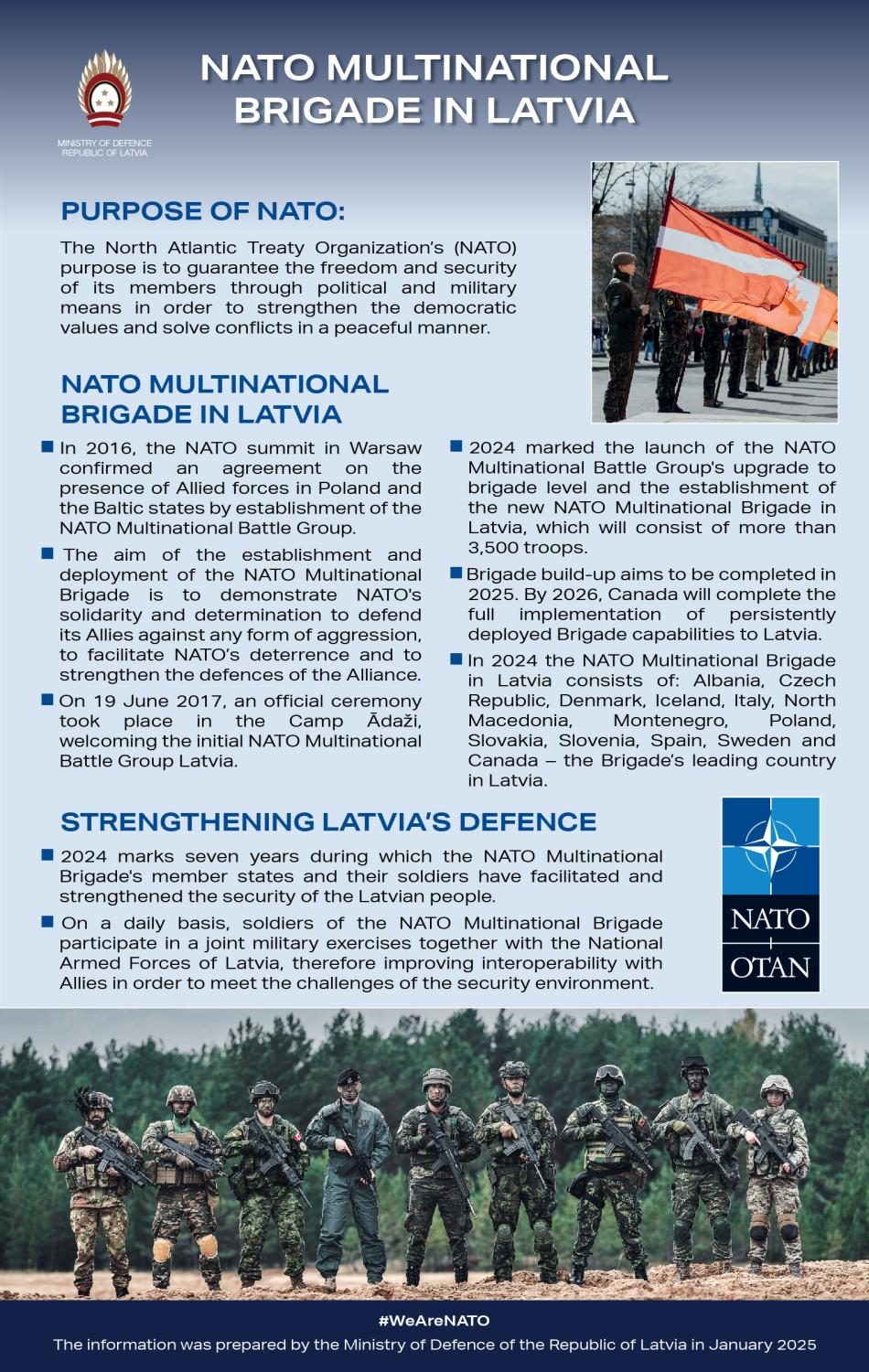NATO Multinational Brigade in Latvia
In view of the changing international security environment, the NATO Summit in Warsaw in July 2016 endorsed the agreement on the presence of Allied Forces in the Baltic States and Poland within the framework of NATO Enhanced Forward Presence. The framework nation of the Multinational Brigade is Canada in Latvia, Germany in Lithuania, the United Kingdom in Estonia and the United States in Poland. This commitment clearly demonstrates the Alliance's unity and commitment to defend NATO members against a potential aggressor. The purpose of the Allied Force presence is to contribute to NATO's deterrence and to strengthen the Alliance's defence.

Canada is the lead nation for the NATO Multinational Brigade deployed in Latvia. In 2017, the initial Battlegroup was joined by troops with weapons from Canada, Spain, Poland, Italy, Slovenia and Albania.In 2018, Slovakia, the Czech Republic and Montenegro joined the Battlegroup, followed by Iceland in 2020, North Macedonia in 2022 and Denmark in 2024. On 12 December 2024, the Swedish Parliament endorsed a proposal to contribute to the NATO Multinational Brigade in Latvia with one mechanised infantry battalion on a long-term basis. In order to strengthen regional security and defence, a Swedish mechanised infantry battalion from the South Skåne Regiment arrived in Latvia on 18 January 2025 to join the NATO Multinational Brigade in Latvia.
The Brigade has become the most multinational NATO military unit.

NATO Multinational Battlegroup Latvia welcome ceremony 2017
On 19 June 2017, the NATO Multinational Battlegroup Latvia (MNBG Latvia) was welcomed at a ceremony at the Ādaži base, where the President of Latvia Raimonds Vējonis, NATO Secretary General Jens Stoltenberg, Latvian Defence Minister Raimonds Bergmanis and Canadian Defence Minister Harjit Sajjan addressed the troops.
The welcoming ceremony was also attended by the Speaker of the Saeima Ināra Mūrniece, Commander of the National Armed Forces Major General Leonīds Kalniņš, representatives of the Cabinet of Ministers, other high-level Latvian officials and representatives of the diplomatic corps.
Also present at the NATO Multinational Battlegroup Latvia welcome ceremony were General James Everard, Deputy Supreme Allied Commander Europe, and the leadership of NATO Commands, General Jonathan H. Vance, Commander of the Canadian Armed Forces, and the Commanders of the Canadian-led Battlegroup member forces.
During the ceremony, a military parade was held with the participation of Canadian, Albanian, Italian, Polish, Slovenian, Spanish and Latvian armed forces.
The NATO Multinational Battlegroup welcoming ceremony at Adazi base concluded the deployment of NATO Multinational Battalion-level Battlegroups in the Baltic States and Poland.
NATO Multinational Battlegroup Latvia development to brigade level
In July 2023, the Latvian and Canadian Defence Ministers signed a roadmap outlining the progress already made and the next steps for the Canadian-led NATO Multinational Battlegroup in Latvia to grow from battalion to brigade level.
The roadmap provides for a step-by-step increase in the level of permanently deployed NATO forces and equipment in Latvia. Latvia confirms its commitment to invest resources in further building up its national defence capabilities and to provide host nation support to the Allies, including the establishment of a new military training ground "Selija".
On 3 July 2024, a ceremony was held at the Ādaži Military Base to mark the launch of the NATO Multinational Battlegroup's upgrade to brigade level and the establishment of the new NATO Multinational Brigade in Latvia, which will consist of more than 3,500 troops.
On 17 October 2024, a change of command of the NATO Multinational Battle Group Latvia took place. The NATO Multinational Battle Group, previously under the command of the Mechanized Infantry Brigade of the Land Forces of National Armed Forces, was transferred to the command of the NATO Multinational Brigade. This means that another combat-capable brigade is now deployed in Latvia, significantly strengthening NATO's deterrence and defence capabilities in the region.
Brigade build-up aims to be completed in 2025. By 2026, Canada will complete the full implementation of persistently deployed Brigade capabilities to Latvia.
Military training
The NATO Multinational Brigade in Latvia participates in both national and international military exercises, jointly with the Latvian Armed Forces.
NATO Multinational Brigade and Ground Forces Mechanized Infantry Brigade regularly conduct joint military exercises Crystal Arrow, Silver Arrow, Summer Shield and Winter Shield.
NATO Multinational Brigade in Latvia Commanders
The rotation of the NATO Multinational Brigade in Latvia Commander position takes place every 12 months.
From June 26 2025 Colonel Kristopher Reeves is the Commander of the NATO Multinational Brigade in Latvia.
From July 2024 to June 26 2025, Colonel Cédric Aspirault was the Commander of the NATO Multinational Brigade in Latvia.
Previous NATO Multinational Battlegroup in Latvia Commanders
Since June 2024, Lieutenant-Colonel Jean-Francois Labonté is the current Multinational Battlegroup Commander.
From December 2023 to June 2024, Lieutenant-Colonel Jonathan Cox.
From June to December 2023, Lieutenant-Colonel Daniel Vincent
From December 2022 to June 2023, Lieutenant-Colonel Craig Higgins



